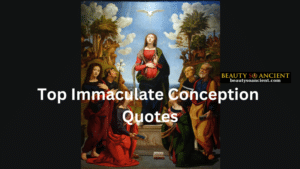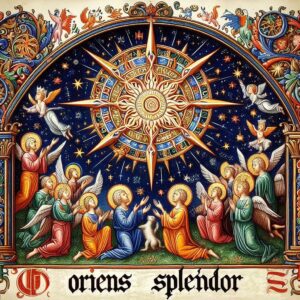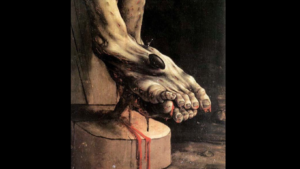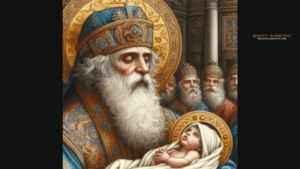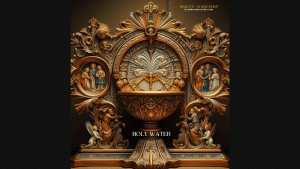The Feast of the Holy Trinity – A Pivot From The Word To Sacred Tradition
Guest post by Joseph Burley
Today on this first Sunday after Pentecost, the feast of the Holy Trinity, we most suitably commemorate that all three Divine Persons contributed to, and shared in, the work of redemption.
The Father sent His Son to earth. The Son, our Savior Jesus Christ, became man and died for our sin.
After Christ’s ascension, the Holy Spirit became our Leader, our Teacher and our Consoler.
We deeply reverence both the individual Persons of the Trinity and the mystical Triune Deity on this day.
One of the reasons I love Holy Mother Church is the wisdom, beauty and order of the Liturgical Year. This is no less illustrated by the celebration of the Most Holy Trinity at this waypoint in the Liturgical Year.
The Positioning of the Feast of the Holy Trinity
“The Liturgical Year,” by Dom Prosper Guéranger , provides instruction on the history and positioning of the Feast of the Most Holy Trinity:
None of the Divine Persons were omitted from each part of Scripture but They were not fully understood. It was God’s good-pleasure to make known to us His essence in a gradual manner:
God, the Father was revealed in the Old Testament; Jesus, the Son, was revealed in the Gospels, and the Holy Spirit in the Acts and Epistles of the Apostles.
The most Holy Trinity is not explicitly mentioned in Holy Scripture. As a result, it would appear the Church did not substantially celebrate the Holy Trinity over the first millennium of its existence.
The Church was “long” in instituting a special feast in honor of the Holy Trinity.

So far back as the eighth century, the learned monk Alcuin had had the happy thought of composing a Mass in honour of the mystery of the blessed Trinity.
It would seem that he was prompted to this by the apostle of Germany, Saint Boniface.
That this composition is a beautiful one, no one will doubt that knows, from Alcuin’s writings, how full its author was of the spirit of sacred liturgy; but, after all, it was only a votive Mass, a mere help to private devotion, which no one ever thought would lead to the institution of a feast.
The Liturgical Year
This votive mass slowly evolved into successive traditions that resulted our existing feast, which officially became sanctioned by Pope John XXII in the 14th century.
The Church’s Instruction on Revelation
It would be instructive at this point to review the Church’s instruction on revelation:
“God has said everything in His Word… and He has no more to say . . . There will be no further (Public) Revelation… Yet even if Revelation is already complete, it has not been made completely explicit; it remains for Christian faith gradually to grasp its full significance over the course of the centuries.”
Catechism of the Catholic Church
The Church’s Instruction on Sacred Tradition
The Catholic Church continues its instruction on the second aspect of Public Revelation, Sacred Tradition:
“In preaching the Gospel, (the apostles) were to communicate the gifts of God to all men. This Gospel was to be the source of all saving truth and moral discipline.
In the apostolic preaching, in keeping with the Lord’s command, the Gospel was handed on in two ways: orally by the apostles who handed on, by the spoken word of their preaching, by the example they gave, by the institutions they established, what they themselves had received — whether from the lips of Christ, .. from His way of life and His works, or whether they had learned it at the prompting of the Holy Spirit; and in writing by those apostles and other men associated with the apostles who, under the inspiration of the same Holy Spirit, committed the message of salvation to writing.
(The Transmission of Divine Revelation) … continued in apostolic succession, this living transmission, accomplished in the Holy Spirit, is called Tradition, since it is distinct from Sacred Scripture, though closely connected to it.
Through Tradition, the Church, in her doctrine, life and worship, perpetuates and transmits to every generation all that she herself is, all that she believes.”
Catechism of the Catholic Church
Divine Intimacy: Meditations on the Interior Life for Every Day of the Liturgical Year
The Pivot
The liturgical year thus far (Advent, Christmas, Lent and Easter) has been principally a celebration and participation in the life of Christ from the Public Revelation of Holy Scripture.
The Feast of the Most Holy Trinity appropriately closes that part of the Church season by honoring and reverencing the individual persons of the Trinity revealed through those seasons.
This same celebration then pivots the Church to open the second half of the Liturgical Year by honoring the mystery of the Trinity that has become more fully understood through the second aspect of Public Revelation: Apostolic Tradition.
The mystery and significance of the Most Holy Trinity has been revealed over time, in part thanks to the teachings of Saints (such as Athanasius, Patrick and Thomas Aquinas).
The dogma of the Holy Trinity was developed at the Council of Nicea and not fully elaborated until the Athanasian Creed, which dates to as late as the 5th or early 6th century.
In the same way, the remainder of the Liturgical year is a celebration and commemoration of those aspects of our faith that are more fully understood by Apostolic Tradition and further amplified by additional Private Revelations, for example:
- the Body and Blood of Christ
- the Sacred Heart
- the Immaculate Heart, the Assumption, Seven Sorrows and Queenship of Mary
- the Most Holy Rosary
- Purgatory
- the Intercession of Saints, and
- the Kingship of Christ.
This reminds us that we have many rich and meaningful feasts remaining on the liturgical calendar to look forward to.
The Mass began as a celebration of the Lord’s Supper. However, over time the Church began to realize the Mass was something greater and therefore began to incorporate elements of sacrifice of the Old Testament and post-Biblical traditions that followed Pentecost.
Since the Council of Trent, every Mass is now a “big picture view” directed to and celebrated in honor of the Blessed Trinity .
In the Lesson on the Feast of the Most Holy Trinity in “Divine Intimacy,”2 the Church Antiphon for the Daily Office is fittingly expressed:
“Caritas Pater est, gratia Filius, communication Spiritus Sanctus, O beata Trinitas!”
This teaches us that the Father is Charity (love), the Son is grace and the Holy Spirit is communication.
He continues (paraphrasing Athanasius, St. Thomas Aquinas et. al):
“The three divine Persons are all co-eternal and equal among Themselves: the divinity and all the divine perfection and attributes are one and the same in the Father, in the Son, and in the Holy Spirit. …The mystery is so sublime and it so exceeds our understanding that we can only bow our heads in silence…In the presence of the unspeakable mystery of the Trinity, the highest praise is silence, the silence of the soul that adores, knowing that it is incapable of praising or glorifying the divine Majesty worthily.”
Divine Intimacy
Where the Protestants Get it Wrong
Through the rejection of Apostolic Tradition, Protestants err in their devotion and understanding of the Trinity.
By focusing almost solely on the personal relationship with the Son, they underestimate the awe, reverence and fear due to the Father.
This same denial of Tradition blinds them to the most intimate aspect of the relationship to the Son, the Blessed Sacrament.
The Holy Spirit becomes misunderstood as a source of gifts and consolation, rather than as the source of Divine communication, obtained principally through silence and contemplation.
While some Protestants accept and still use the Athanasian Creed to this day, the Catholic Church is unique is understanding the full personhood of the Trinity as revealed through Sacred Tradition and Private Revelation.
It would seem most fitting on this holy day that we make special efforts to honor God through acts of charity, to honor the Son through reception of Holy Communion and prayer to receive grace and recognize workings of the Holy Spirit through a period of devout silence.
Sources
- St. Joseph: Unleash the Terror of Demons - March 19, 2025
- Two Candles, Two Doves and a Sword| Feast of Candlemas - February 2, 2025
- Hey, Wise Up! The Epiphany Story Revealed in New Light - January 6, 2025




